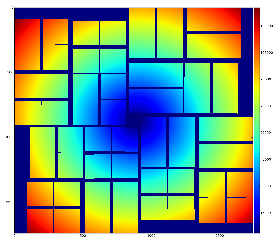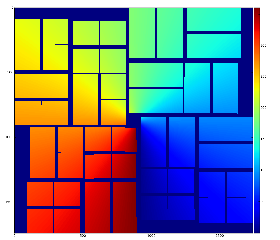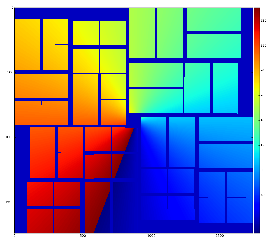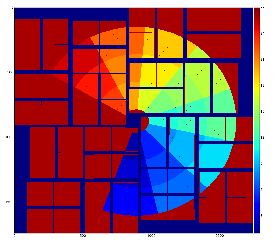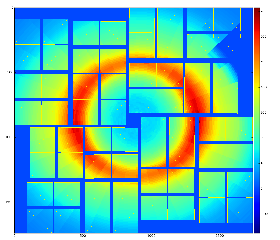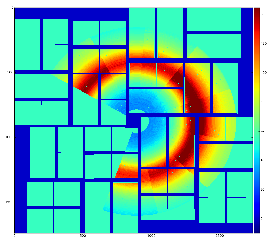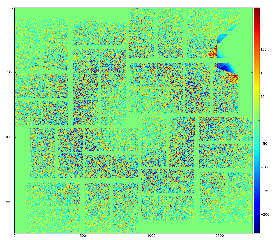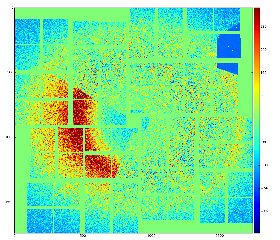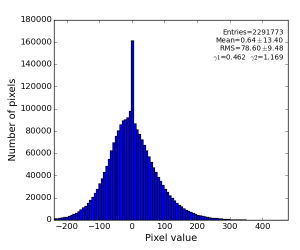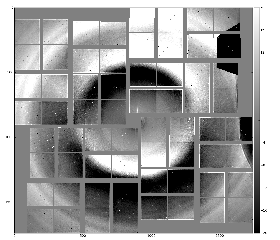Content
Code location
In LCLS software release code of the class RadialBkgd resides in the package pyimgalgos.
Auto-generated documentation for class RadialBkgd
Initialization
from pyimgalgos.RadialBkgd import RadialBkgd rb = RadialBkgd(xarr, yarr, mask=None, radedges=None, nradbins=100, phiedges=(0,360), nphibins=32)
See parameters' description in Auto-generated documentation for class RadialBkgd.
Input n-d arrays can be obtained through the Detector (AreaDetector) interface or directly through the class working with geometre:
from PSCalib.GeometryAccess import GeometryAccess geo = GeometryAccess(fname_geo) xarr, yarr, zarr = geo.get_pixel_coords() iX, iY = geo.get_pixel_coord_indexes() mask = geo.get_pixel_mask(mbits=0377) # mask for 2x1 edges, two central columns, and unbound pixels with their neighbours ...
Algorithm
Intention
This algorithm is intended to subtract background from images with quasi-symmetric radial distribution of intensities.
For example, pure water ring background from exp=cxij4716:run=22:
To evaluate background in data, n-d array of data is split for 2-d bins in polar coordinate frame, total intensity and number of involved pixels are counted for each bin and converted to the average bin intensity.
Then this averaged intensity is per-pixel subtracted form data n-d array.
Description
Input per-pixel coordinates passed in numpy arrays xarr, yarr are used to evaluate per-pixel radius and polar angle:
rad = rb.pixel_rad() phi = rb.pixel_phi()
Binning parameters radedges, nradbins, phiedges, nphibins are used to initialize 2-d bins using class HBins. Initialization with default binning parameters covers entire detector coordinate space.
Non-default binning, for example like
rb = RadialBkgd(X, Y, mask, nradbins=3, nphibins=8, phiedges=(-20, 240), radedges=(10000,80000))
defines angular pixel coordinates with correct offset relative to minimal angle,
and gives 3 bins in radial direction from 10mm to 80mm and 8 bins in angle from -20 to 240 degree:
rad = rb.pixel_rad() iseq = rb.pixel_iseq()
Pixels masked by the n-d array passed in the parameter mask are excluded from this algorithm and are not corrected.
Averaged background intensity for default and non-default binning cases (nphibins=8, nradbins=500):
bkgd = rb.bkgd_nda(nda)
Background subtraction
Background subtracted data for default (nradbins=100, nphibins=32) and non-default binning cases (nradbins=500, nphibins=1), and (nradbins=500, nphibins=8, phiedges=(-20, 240)):
res = rb.subtract_bkgd(nda)
Polarization correction
- For good statistical precision of the background averaging 2-d bins should contain large number of pixels. However large bins produces significant binning artifacts which are seen in resulting image.
- The main reason for angular bins is a variation of intensity with angle due to polarization effect. The beam polarization effect can be eliminated with appropriate correction.
Method for polarization correction factor:
Then, radial background can be estimated for a single angular bins (ring-shaped radial bins):
pf = polarization_factor(rb.pixel_rad(), rb.pixel_phi(), z) res = rb.subtract_bkgd(nda * pf)
For z=1m we get polarization correction factor, corrected data (water-ring) sample, and background subtracted data as follows.
Effect of polarization is somehow accounted, but most likely the sample-to-detector distance 1m is not correct.
The data set exp=cxij4716:run=22 was collected at sample-to-detector distance z=94mm. In this case polarization correction formula gives distribution for correction factor and "corrected" data averaged over all 14636 events:
So, it looks like polarization correction formula is wrong
CSPAD "dopping" artifacts
arr = load_txt(fname_nda) rb = RadialBkgd(X, Y, mask, nradbins=500, nphibins=1) pf = gu.reshape_to_2d(polarization_factor(rb.pixel_rad(), rb.pixel_phi(), 0.5e6)) nda = rb.subtract_bkgd(arr * pf) * mask.flatten()
Polarization corrected, radial background subtracted image, array spectra, and zoomed parts of the image with potential artifact candidates:
References


